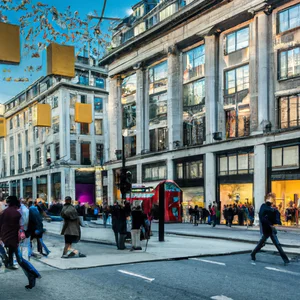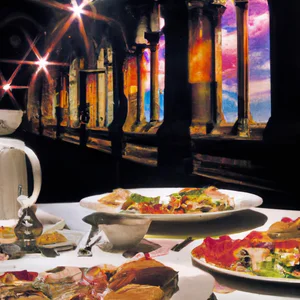Book your experience
Shopping in London
Let’s talk about shopping in London, which is a bit like a treasure hunt, but without the pirate’s map, you know? Let’s start from Oxford Street, which is practically paradise for those who love to shop. You know, that really long street full of shops? It’s like a river full of people coming and going, and you feel a bit like a leaf carried by the current, sometimes a bit overwhelmed, but well, it’s all part of the fun!
Then, there are the vintage markets, which are a real gem, in my opinion. Imagine wandering around stalls full of used stuff, a bit like finding treasures in the attic. One afternoon, I went to Camden Market and found a jacket that looked like it came out of an 80s movie. I think it was one of my best discoveries, and who would have thought? Although, to be honest, every now and then I wonder if it was really that popular at the time or if I just dreamed it!
Well, returning to Oxford Street, it’s easy to get carried away. Maybe you walk into a store and find something amazing, but then you remember that you have a budget to stick to. I mean, who hasn’t thought, “What am I doing with all these shoes?” Yet, your heart beats faster when you see a pair that makes your eyes shine. It’s a bit like falling in love, isn’t it? You may know it’s not the right time, but the pull is irresistible.
However, let’s not forget about the markets, because there you can really find everything: clothes, vintage objects and, sometimes, even a bit of extravagant art. The last time I went there, I saw a guy selling old vinyl records. And I said to myself, “Damn, who still buys vinyl?” Yet, there was a line of people, all looking like connoisseurs, as if they were searching for the Holy Grail of music. Most likely, I would have ended up in it too, because at the end of the day, who doesn’t love a little nostalgia?
In short, London offers a crazy mix of the new and the old, and each shop has a story to tell. If you feel like getting lost in the streets and maybe making some impulsive purchases, well, this city is just the right place. And who knows, maybe you’ll come home with a souvenir that you didn’t even put on the list, but which turns out to be your new favorite piece!
Oxford Street: The modern shopping paradise
A Personal Experience
I remember my first trip to London, when I found myself walking down Oxford Street, surrounded by a hubbub of voices and colours, with the glittering shop windows seeming to call to me. The feeling of being in the beating heart of the British capital, with shops stretching as far as the eye could see, was indescribable. Every step seemed like an invitation to discover new trends, from fast fashion to high fashion brands.
Practical Information
Oxford Street is London’s most famous shopping street, with over 300 shops offering everything from international brands such as Zara and H&M to iconic stores such as Selfridges. The street is easily accessible by tube, getting off at the Oxford Circus or Bond Street stop. During the holidays, the street transforms into a real light show, making the atmosphere even more magical. According to the official Visit London website, Oxford Street attracts more than 200 million visitors a year, making it one of the busiest destinations in the world.
Insider advice
A little-known tip for serious shopping enthusiasts is to visit Oxford Street during early opening hours, usually around 9am. This way, you can avoid the crowds and have access to new collections before they are “shot” onto the store floor. Also, don’t forget to explore the lesser-known shops found on the side streets; here you could find unique items at unbeatable prices.
Cultural and Historical Impact
Oxford Street is not just a shopping location; it is a symbol of London’s commercial culture. The street has a history dating back to Roman times, when it was part of a route linking London to St. Albans. Today, it represents a fusion of tradition and modernity, where the past meets the latest fashion trends. This cultural mix makes the shopping experience here not just an act of consumption, but also a celebration of London’s diversity and creativity.
Sustainability in Shopping
As environmental awareness increases, many shops along Oxford Street are adopting sustainable shopping practices. Brands such as COS and H&M have launched eco-friendly fashion lines, promoting the use of recycled materials and responsible production methods. Choosing to buy from these brands not only allows you to be fashionable, but also contributes to a more sustainable future.
An Activity to Try
While exploring Oxford Street, stop in Selfridges for afternoon tea in their famous The Terrace restaurant. Enjoy a moment of relaxation with a selection of fine teas and artisanal desserts, a perfect way to recharge your batteries after a shopping session.
Myths to dispel
A common misconception is that shopping on Oxford Street is only for tourists. In fact, many Londoners frequent this area for its offers and the latest trends. Don’t be fooled into thinking that shopping here is just expensive; there are options for every budget, and seasonal sales offer unmissable opportunities.
Final reflection
As you walk away from Oxford Street, ask yourself: What have you discovered new about yourself through the art of shopping? This experience is not just a way to shop, but also an opportunity to explore, express yourself and connect with the vibrant London culture. Next time you visit this iconic street, remember that every purchase can tell a story, your story.
Vintage markets: London’s hidden treasures
A personal experience
I still remember my first encounter with Camden Market, on a frosty November morning. As I walked among the stalls, the scent of spices and the sound of acoustic guitars floated in the air. It was there that I found a one-of-a-kind vintage 1970s coat that told stories of bygone eras. That discovery wasn’t just a deal, but an experience that made me feel part of London’s vibrant culture. The vintage markets, with their hidden treasures, are a real paradise for those looking for something original and authentic.
Practical information
London is dotted with vintage markets, each with its own distinctive character. Among the most famous, the Portobello Road market and the Brick Lane market are obligatory stops. If you want a more intimate experience, don’t miss Camden Market, open daily from 10am to 6pm. For up-to-date information on the markets, you can consult the official Visit London website.
An insider tip
A secret that few people know is that Bermondsey Antiques Market, open on Friday mornings, is a real treasure trove for antique hunters. This market is less crowded and offers unique pieces at competitive prices. Arrive early and bring cash, as many vendors don’t accept credit cards!
Cultural and historical impact
London’s vintage markets are not just places for shopping, but real time capsules that reflect the different eras of British culture. These spaces have deep roots, dating back to the post-war period, when people sought creative ways to reuse what they had. Today, these markets have become symbols of a culture that celebrates sustainability and reuse, attracting visitors and collectors from all over the world.
Sustainable tourism practices
Opting for vintage is not just a style choice, but also a step towards more sustainable tourism. Purchasing garments used, help reduce the production of new items and support a circular economy. Plus, many vendors at these markets are small, local businesses, meaning your purchase will have a direct impact on the community.
Atmosphere and involvement
Walking among the stalls, let yourself be enveloped by the liveliness and energy of the place. Every corner tells a story, and sellers are often happy to share anecdotes about their items. Imagine browsing through piles of used clothes, while live music fills the air and the scent of ethnic foods invites you to stop for a snack.
Activities to try
In addition to shopping, consider attending an upcycling workshop at one of the many creative studios found at vintage markets. This experience will not only allow you to give new life to an old object, but will also offer you the opportunity to interact with local artists and learn new techniques.
Myths and misconceptions
A common misconception is that vintage markets are only for fashion fanatics. In fact, these spaces offer a wide range of items, from vintage furniture to art, making them accessible to everyone, regardless of their personal style. Furthermore, the quality of the garments is often superior to that of fast fashion stores.
Personal reflection
Every time I visit a vintage market, I ask myself: how many stories would these objects tell if they could talk? The beauty of vintage lies not only in its aesthetic appearance, but in the stories it brings with it. Next time you’re in London, take a moment to explore these markets and be amazed by the treasures that await you.
The independent boutiques of Covent Garden
A personal experience in the heart of London
When I visited Covent Garden for the first time, I was immediately captivated by the lively atmosphere and energy that permeated the air. While walking through the shops, I came across a small boutique called “Memento Mori”, specializing in local handcrafted items. The smell of fresh wood and scented candles greeted me, and the owner, a talented artist, told me the story behind each piece for sale. This chance meeting was the start of a love for Covent Garden’s independent boutiques, where each shop seems to tell a unique story.
Practical and up-to-date information
Covent Garden is one of the most iconic areas of London, not only for its theaters and restaurants, but also for its independent boutiques. Here, you can find everything from vintage clothing to handcrafted jewelry. Some of the best-known shops include Anthropologie for bohemian clothing and The Cambridge Satchel Company, where you can discover handmade leather bags. It is advisable to visit during the week to avoid the crowds and have a more intimate shopping experience.
Unconventional advice
A secret that few know is that many Covent Garden boutiques offer special discounts for tourists who show their passport. Don’t forget to ask if there are any offers available at checkout!
The cultural and historical impact
Covent Garden, once a fruit and vegetable market, has transformed over the centuries into a vibrant cultural centre. Independent boutiques not only offer unique products, but are also custodians of artisan traditions that are passed down from generation to generation. These shops help keep London’s historic identity alive, serving as spaces for creativity and innovation.
Sustainable tourism practices
Buying from independent boutiques is also a responsible tourism choice. Many of these shops are committed to sustainability, using recycled or natural materials and supporting local artisans. By choosing to shop here, you support the local economy and contribute to more ethical fashion.
Vivid and engaging atmosphere
Walking through the cobbled streets of Covent Garden, you will feel immersed in an atmosphere of creativity and passion. The sounds of street performers, people’s laughter and the smell of fresh food from the surrounding kiosks create a vibrant environment that stimulates the senses. Each boutique has its own charm, with uniquely decorated windows that invite you to discover what lies inside.
An unmissable activity
Don’t miss the chance to participate in a craft workshop in one of the boutiques. Many shops offer classes to learn how to make jewelry or paint pottery, allowing you to take home not only a souvenir, but also a memorable experience.
Debunking common myths
A common misconception is that independent boutiques are always too expensive or exclusive. In fact, many offer affordable and unique products, often of higher quality than mass-market brands. Plus, shopping here lets you discover pieces you’ll never find in department stores.
A personal reflection
Next time you’re in London, take a moment to explore the independent boutiques of Covent Garden. I invite you to reflect on how rich and meaningful the shopping experience can be when you choose to support local artists and artisans. What stories would you discover in the stores you visit?
Sustainable shopping: Eco-friendly fashion in London
A personal experience
I remember my first stay in London, while walking through the streets of Shoreditch, I came across a small sustainable clothing shop called The Good Trade. Having entered out of curiosity, I was greeted by a warm and welcoming atmosphere, with clothes made from recycled materials and local artisans. Each piece told a story, not just about fashion, but about responsibility and awareness. This chance encounter changed the way I looked at shopping, leading me to explore the growing eco-friendly fashion scene in London.
Practical and up-to-date information
London is a true epicenter for sustainable shopping, with shops ranging from well-known chains to independent boutiques. Places like Nudie Jeans and People Tree offer ethical clothing options, while in neighborhoods like Camden and Notting Hill you can find markets that promote reuse and recycling. According to the Association of Sustainable Shops in London, the number of eco-friendly businesses has increased by 30% in the last five years. This information is also available on their official website, where you can find a map of eco-sustainable stores.
An insider tip
A little-known tip is to visit the pop-up shops popping up all over the city. Often, these pop-up shops offer unique, limited-time products created by emerging designers, all with a strong commitment to sustainability. To find out where they are, check local artists’ social media pages or join Facebook groups dedicated to sustainable fashion in London.
Cultural and historical impact
The movement towards sustainable fashion in London is not just a trend, but a reflection of a growing cultural awareness of environmental issues. In the 1960s, London was already a center of innovation and creativity, and today, with designers like Stella McCartney making sustainability her trademark, the city continues to be at the forefront. This evolution has led to a change in the way consumers perceive fashion, transforming it into a more responsible industry.
Sustainable tourism practices
Choosing to shop in sustainable stores not only supports the local economy, but also reduces your environmental impact. Many of these stores use recycled materials and manufacturing practices ethics, which contribute to more responsible fashion. Also, consider bringing your own reusable bag to reduce plastic waste while shopping.
An activity worth trying
If you want to fully immerse yourself in this experience, take part in an upcycling workshop, where you can transform old clothes into unique new items. Places like The Fashion School offer courses that not only teach you how to create, but also understand the value of sustainable fashion.
Common myths
A common misconception is that sustainable fashion is expensive. In fact, many eco-friendly stores offer items at competitive prices, and buying quality pieces that last can be more convenient than buying fast fashion.
Final reflection
After discovering the world of sustainable fashion in London, I asked myself: what impact do I want to have with my purchasing choices? Every time we enter a store, we have the opportunity to support a greener future. Next time you are in London, why not explore this fascinating dimension of fashion?
Portobello Road: A journey through time
A personal anecdote
I vividly remember my first visit to Portobello Road: the sun was shining high in the London sky and the air was filled with a mix of street food scents and exotic spices. While walking among the stalls, I came across an elderly vintage record seller, whose nostalgia-lit gaze told stories of a bygone era. It was at that moment that I understood that Portobello Road is not just a market, but a real open-air museum where every object has a story to tell.
Practical information
Portobello Road is one of London’s most iconic markets, located in the Notting Hill district. It extends for over a kilometer and offers a wide range of products, from antiques to vintage fashion. The market is open every day, but Saturday is the highlight, with hundreds of vendors gathering to offer their wonders. For up-to-date information, you can consult the official Portobello Road Market website, which provides details on special events and opening times.
An insider tip
Here’s a little-known tip: If you want to avoid the Saturday crowds, try visiting the market during the week. Not only will you have the chance to explore the stalls at your leisure, but you may also discover unique pieces that go on sale before the weekend. Additionally, Notting Hill’s local shops and boutiques are open and ready to offer a warm and personal welcome.
Cultural and historical impact
Portobello Road has a rich and fascinating history, dating back to the 18th century when it was a simple country road. Today, it represents a crossroads of cultures, a place where British traditions and international influences intertwine. This market also has a strong connection to the local community: many of the vendors are long-time residents who carry on the art of trading and hospitality, helping to keep London’s culture alive.
Sustainable tourism practices
Portobello Road also promotes sustainable tourism practices. Many sellers are committed to using recycled materials and reducing the use of plastic, offering eco-friendly products. Plus, most of the shops and stalls are run by small businesses, meaning your purchase helps support the local economy.
A unique atmosphere
Walking along Portobello Road, you will feel transported to another era. The bright colors of the stalls, the melodies of the street musicians and the animated conversations of the visitors create a vibrant and welcoming atmosphere. Every corner offers the possibility of discovering a hidden treasure, be it a rare record or an antique.
An activity worth trying
Don’t miss the opportunity to visit the famous Portobello Market Antiques, where you can browse through vintage objects and maybe find that unique piece that was missing from your collection. Furthermore, I recommend stopping at one of the local cafes to enjoy a traditional afternoon tea, a perfect way to end your visit.
Myths and misconceptions
A common misconception is that Portobello Road is for tourists only. In reality, it is also a place frequented by Londoners, who visit it to find unique products and support the local economy. The diversity of the offering is such that there is something for everyone, from the collector to the fashion enthusiast.
Final reflection
The next time you are in London, ask yourself: what can the objects I buy tell you? Portobello Road is not just a market, but a journey through time, where every purchase becomes part of a bigger story. Are you ready to discover your story in Portobello?
Looking for souvenirs: Alternative markets
A personal anecdote
I still remember my first visit to the Brick Lane market, where the air was filled with a mix of scents, from oriental spices to freshly baked pastries. As I wandered through the stalls, I noticed an artisan creating unique jewelery from recycled materials. His passion was palpable and, after a quick chat, I went home with a bracelet that told a story – a story of London and its rich alternative culture. This is exactly what London’s alternative markets offer: not just souvenirs, but also authentic experiences and connections.
Practical information
London is dotted with alternative markets, perfect for those looking for unique and meaningful souvenirs. As well as Brick Lane, don’t miss Camden Market, famous for its vibrant atmosphere and artisanal products. At Greenwich Market you can find vintage items and works by local artists. Most of these markets are open on weekends, but always check the official websites for hours and special events. For example, the Camden Market website offers regular updates on events and pop-up markets.
An insider tip
If you really want to discover unique items, visit the markets early in the morning, before tourists crowd the streets. This will give you the opportunity to chat with the sellers and discover interesting stories behind each item. In fact, some sellers offer discounts if they notice real interest in their products.
Cultural and historical impact
London’s markets aren’t just shopping places; they are also spaces of social and cultural interaction. Since the Middle Ages, markets have represented a meeting point for different communities, encouraging trade and the exchange of ideas. Today, these markets continue to play a vital role in the life of the city, reflecting its diversity and creativity.
Sustainable tourism practices
Many alternative markets promote sustainable practices, such as using recycled materials and selling local products. Choosing to purchase from local artisans and producers not only supports the community economy, but also reduces the environmental impact associated with the transport of goods.
Immersion in the atmosphere
Imagine strolling among the colorful stalls of Portobello Road, with their displays of vintage items and local crafts, while the sound of live music fills the air. Every corner tells a story, every object has a memory to share. It’s a sensory experience that goes beyond the simple act of purchasing.
Suggested activity
If you fancy an unforgettable experience, join a craft workshop at one of the markets, such as Spitalfields Market, where you can learn to make your own personalized souvenir. Not only will you take home a unique item, but you will also have a tangible memento of your London adventure.
Myths and misconceptions
A common misconception is that alternative markets are only for tourists. In fact, they’re also popular with Londoners, who see them as a great way to discover fresh produce, unique crafts and delicious food. Don’t be put off by the crowds; explore and be surprised by what you will find!
A final reflection
As you venture through London’s stalls, ask yourself: what stories lie behind the souvenirs I buy? Each piece you choose is a chapter of your travel experience. Have you ever wondered which objects tell your story?
Street food and shopping: A perfect combination
When I ventured onto the streets of London, I never imagined I would discover how delicious the combination of shopping and street food could be. It was a sunny day, and as I strolled along lively Brick Lane, the air was filled with a heady mix of spices and sweets. Between a vintage shop and an independent boutique, I heard the call of a kiosk serving the best salt beef bagels in the city. At that moment, I realized that shopping here was not just an activity, but a complete sensory experience.
A culinary journey through the shop windows
London is famous for its street food, and markets such as Borough Market and Camden Market offer a myriad of food options, perfect for a break between shopping. According to the official Visit London website, Borough Market is one of the city’s oldest food markets, with over 100 vendors offering fresh produce and dishes from around the world. Here you can taste everything, from artisanal doughnuts to ethnic dishes that tell stories of different cultures.
An insider tip
If you want a street food experience that challenges convention, try visiting Dinerama Market in Shoreditch. It’s not just a market, but a real food festival, where emerging chefs present innovative dishes every week. The best thing? On some weekends, you can find themed events that combine street food and live music, creating a vibrant and festive atmosphere.
Street food culture in London
The street food phenomenon has deep historical roots in London, dating back to medieval markets. Today, street food has become a symbol of culinary diversity and innovation, reflecting the multiple cultures that coexist in this cosmopolitan city. Local entrepreneurs and food trucks are redefining the concept of dining, bringing affordable gourmet dishes, and making street food a democratic experience.
Sustainability on the move
Many street food operators in London make conscious use of local ingredients and sustainable practices. For example, some kiosks use compostable packaging and try to reduce food waste, an important step towards responsible tourism. Choosing to eat at these markets is not only a way to support the local economy, but also to contribute to a more sustainable future.
An unmissable activity
If you are looking for an experience that combines shopping and gastronomy, I recommend taking a food tour. Several companies, such as Eating London Tours, offer guided experiences that take you through London’s most iconic street food markets, allowing you to savor delicious dishes while exploring unique boutiques and shops.
Myths to dispel
A common misconception is that street food is always unhealthy or low quality. In fact, many vendors are passionate about cooking and are committed to creating fresh and delicious dishes. The quality of the ingredients and preparation are generally very high, and many options are also vegan or vegetarian.
A final reflection
Next time you’re strolling the streets of London, remember that shopping can go far beyond purchasing items. What is the local dish you can’t wait to enjoy while exploring the city? The answer may surprise you and make your travel experience even richer and more memorable.
Spitalfields Market: History and Modernity
When I first set foot in Spitalfields Market, I was immediately struck by the fusion of history and modernity that permeates every corner. The first time I visited this place, I found myself walking among the stalls of emerging artisans and designers, while the scent of ethnic food enveloped the air. It is an experience that seems to tell a story of tradition and innovation, perfectly balanced.
A little history
Founded in 1682, Spitalfields Market has deep roots in London’s history. Originally conceived as a food market, today it is a vibrant center of culture and creativity, where artists, designers and artisans gather to present their works. Historic red brick structures sit alongside modern spaces, creating a unique atmosphere that chronicles the area’s transition from a trading post to a cultural epicenter.
Tips for visiting
For an authentic experience, I recommend visiting the market on weekends, when special events and thematic markets take place. Don’t forget to tuck into a plate of street food from the many stalls, offering a range of international cuisines. An insider suggested I try Indian curry from one of the local vendors, an experience you won’t be able to forget.
Cultural impact
Spitalfields is not only a place of shopping, but also a crossroads of different cultures. The market is a refuge for artists and creatives, who find here a space to express themselves and share their works. This mix of cultures helps make London such a vibrant and cosmopolitan city, where every visit to the market is an opportunity to discover new influences and stories.
Sustainability and responsibility
In an era where responsible consumption has become crucial, Spitalfields Market stands out for its attention to sustainable practices. Many of the vendors offer products made from recycled or ethically sourced materials, allowing visitors to make informed purchases without compromising on style.
An experience not to be missed
During your visit, take a moment to stop by the cafe located on the corner of the market. Here, you can sip an artisanal coffee while people-watching, fully immersing yourself in the lively atmosphere of the place.
Myths and misconceptions
A common myth is that Spitalfields Market is for tourists only. In reality, it is a place frequented by locals, who consider it a point of reference for design and art. This gives you the opportunity to have an authentic experience and interact with London’s creative community.
In conclusion, Spitalfields Market is a microcosm of London that unites past and present in a way that few other places can match. I invite you to ask yourself: what unique story will you have the opportunity to tell after a visit to this extraordinary market?
Night shopping in London: An experience not to be missed
I remember a magical evening in London, when I found myself walking along Oxford Street after dark. The shop lights shone like stars in a night sky, transforming the daytime frenzy into an almost enchanted atmosphere. With shops closing later than other European cities, London offers a unique opportunity to enjoy shopping in a different, more relaxed and charming setting.
The magic of night lights
The beauty of night shopping in London lies not only in being able to walk around without the daytime crowds, but also in seeing the illuminated shop windows featuring the latest fashion trends. In this context, the fresh evening air becomes part of the experience, making every purchase a small event. Iconic stores like Selfridges and Zara stay open late, offering the chance to explore at a leisurely pace. Remember to check opening hours, as some shops may have varying hours depending on the day of the week.
An insider tip
Here’s a little-known tip: many stores offer special discounts and promotions on shopping nights, so don’t forget to ask! Plus, some pubs and cafes nearby offer discounts to those who present a recent purchase receipt, allowing you to enjoy a beer or coffee while you re-energize.
A cultural impact
Night shopping in London reflects a lively and dynamic culture, where people don’t just buy, but enjoy a social experience. This tradition has grown over the years, making the city a point of reference for global shopping. During the evening hours, the streets come alive with street artists and musicians, creating an atmosphere that turns every purchase into a small celebration.
Sustainability and responsibility
In an age where sustainable tourism is increasingly important, night shopping can be an opportunity to discover local boutiques and eco-friendly brands that promote sustainable practices. Buying from these shops not only supports the local economy, but also allows you to bring home a piece of London with a significant history.
An experience worth trying
If you decide to live this experience, I recommend visiting Carnaby Street and Covent Garden after dark. Here you will find not only exclusive shops, but also restaurants and bars that vibrate with life. You may also come across special events or pop-up sales, making each visit unique.
Final reflection
Contrary to the common belief that London is a city to be explored only during the day, night shopping offers an opportunity to see the most enchanting and vibrant side of the capital. Have you ever wondered what stories your purchases could tell if they could talk? Next time you’re in London, why not explore the wonders of this city under the stars?
Local Experiences: Family-run cafes and shops
A personal anecdote
I remember my first trip to London, when I got lost in the streets of Notting Hill, my mind crowded with images of romantic films and bright colours. While looking for a place to refresh myself, I came across a small family-run café called “The Blue Door Café”. Here, the scent of freshly brewed coffee mixed with that of homemade desserts, and the warm welcome of the owner, a middle-aged lady with an infectious smile, made me feel immediately at home. It was at that moment that I realized how much London can offer not only shops, but also authentic experiences, rooted in the local community.
Practical information
If you want to discover the more authentic side of London, immerse yourself in less touristy neighbourhoods, such as Clapham or Stoke Newington, where family-run cafes and shops thrive. Places like “Kraft Dalston” and “The Hackney Coffee Company” offer not only great drinks, but also a selection of unique artisan products. You can find up-to-date information on events and openings on sites like TimeOut London and VisitLondon, which always offer great ideas for exploring the city.
A little-known tip
Here’s a tip only an insider knows: Many of these small businesses offer discounts or special promotions for those who stop to chat with the owners. Don’t be afraid to ask for stories about their craft or the history of the shop; often, a simple exchange of words can reveal exclusive offers or limited edition products.
Cultural and historical impact
These cafes and shops aren’t just places to shop, they represent a piece of London’s history. Many of them have been passed down from generation to generation, preserving unique traditions and recipes. Buying in these places also means supporting the local economy and preserving the distinctive character of London neighborhoods, increasingly threatened by gentrification.
Sustainable tourism practices
Choosing to shop in family-run shops and taste local coffees is also a step towards more sustainable tourism. These places tend to use local ingredients and responsible production practices, helping to reduce their ecological footprint and support local producers.
Immerse yourself in the atmosphere
Imagine sitting in a cafe overlooking a cobbled street, with a steaming cup of tea in your hands and the sound of customers laughing around you. The walls are decorated with works by local artists, while the scent of freshly baked pastries invites you to examine the menu carefully. In these places, every detail tells a story, from the design of the venue to the voices that animate it.
Recommended activity
I recommend taking a walking tour of London’s family-run cafes and shops. These tours, often organized by local guides, will take you to hidden corners of the city where each stop offers a new discovery. You’ll be surprised by how much you can learn about London culture simply by chatting to those who experience it every day.
Myths to dispel
A common misconception is that mom-and-pop shops are always more expensive than large chains. In fact, many of these places offer competitive prices and, in some cases, superior products. Plus, the value of a purchase that supports the community is invaluable.
Final reflection
Next time you visit London, take a moment to explore the family-run cafes and shops. I invite you to consider: how much can authentic contact with local culture enrich your travel experience? Discovering these hidden gems could prove to be the most treasured memory of your stay.

 Architecture and Design
Architecture and Design Cities and Regions
Cities and Regions Culture and History
Culture and History Events and Festivals
Events and Festivals Fashion and Shopping
Fashion and Shopping Food and Wine
Food and Wine Nature and Adventure
Nature and Adventure Unique Experiences
Unique Experiences



























